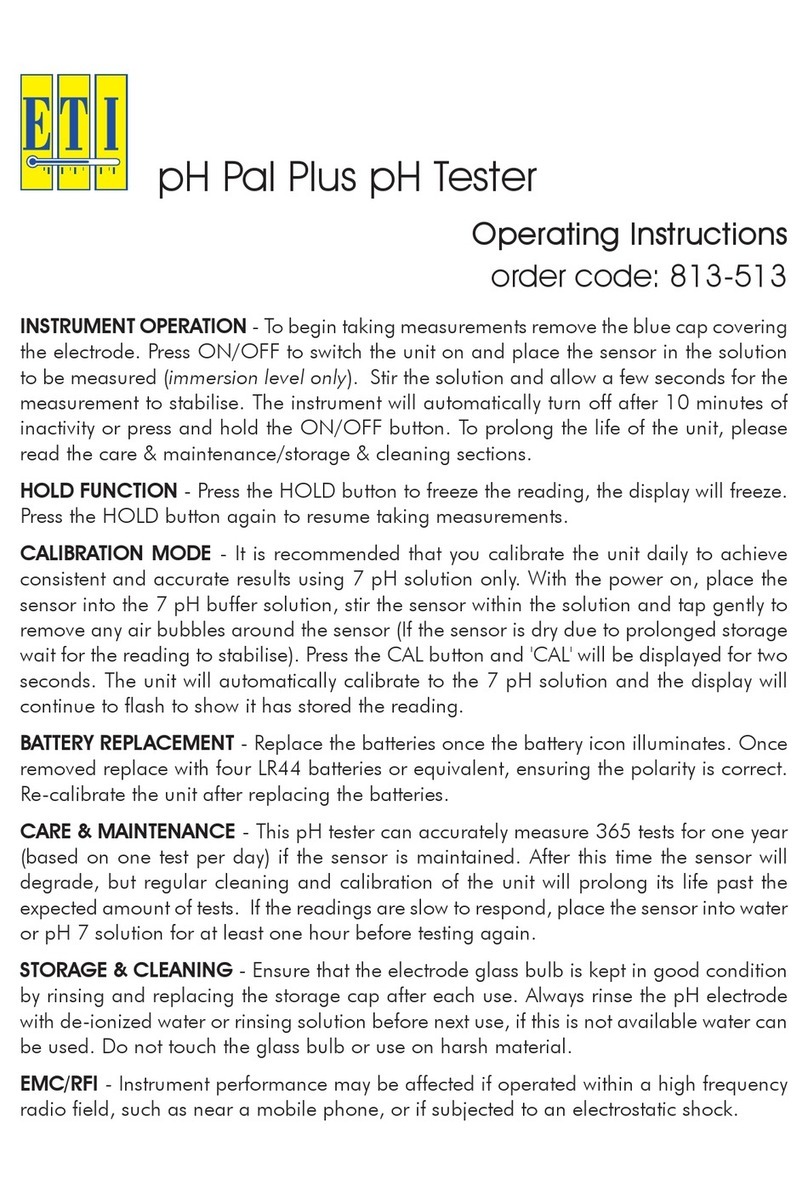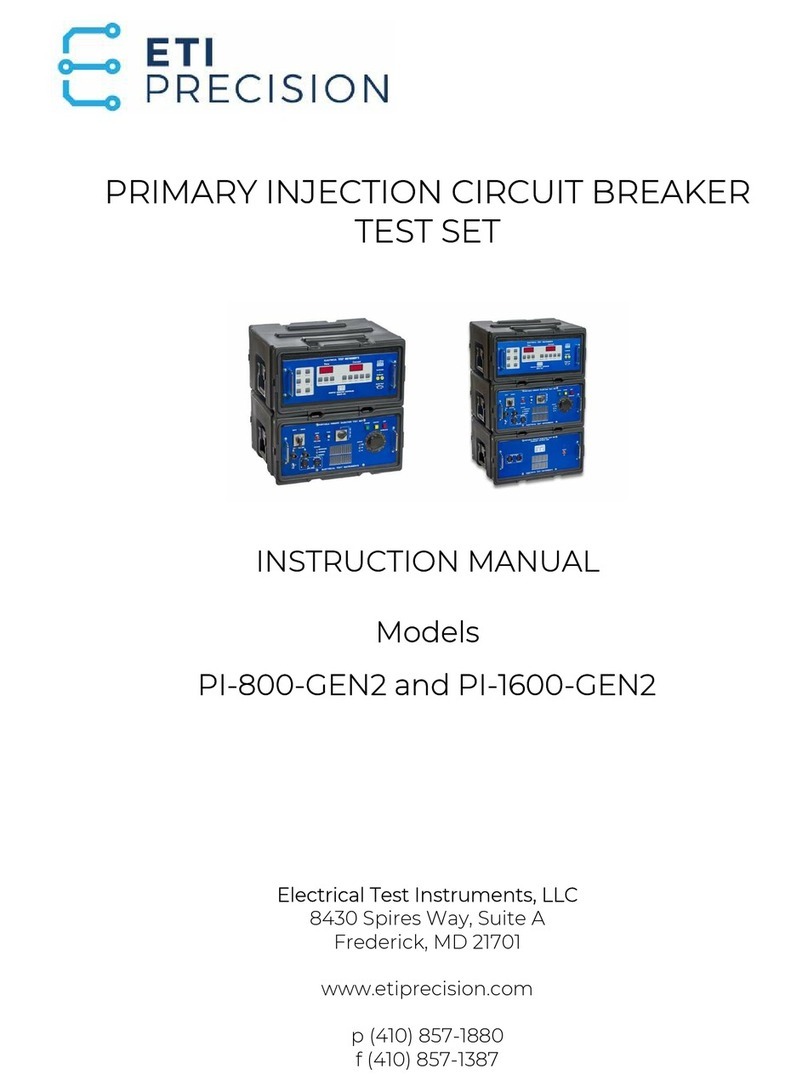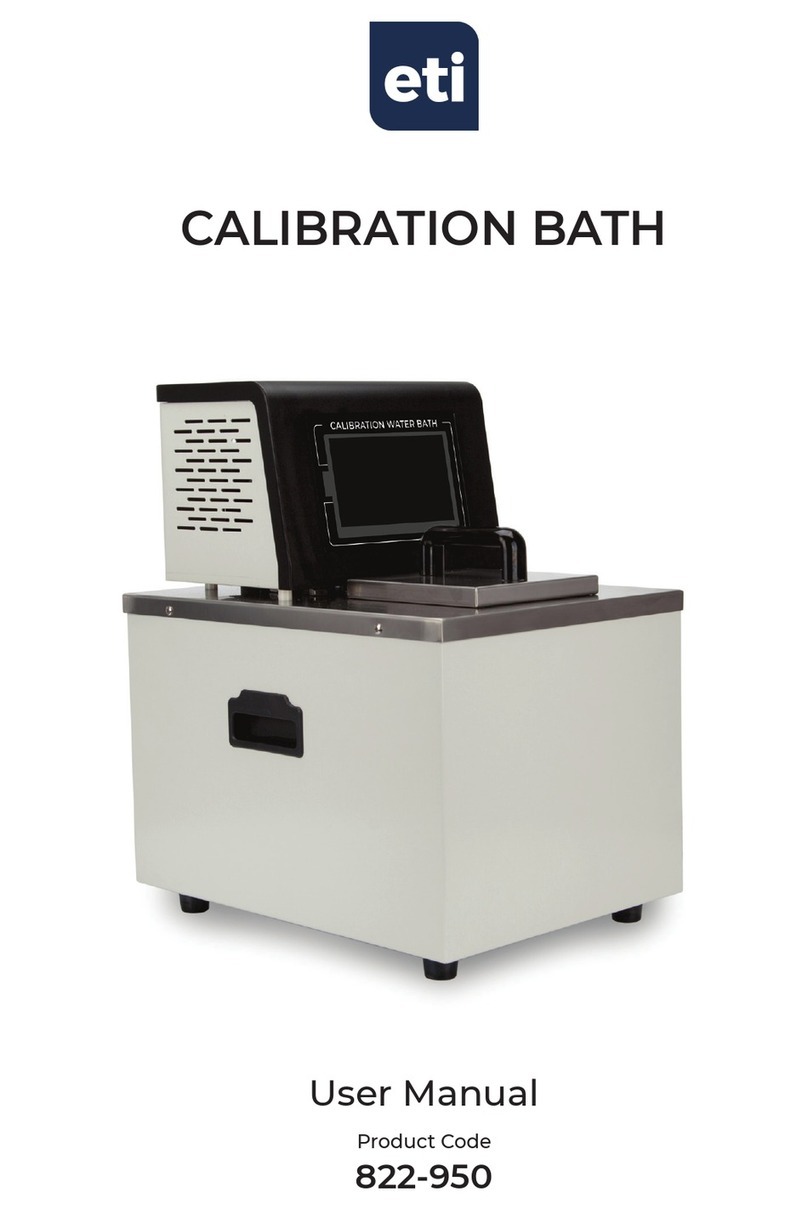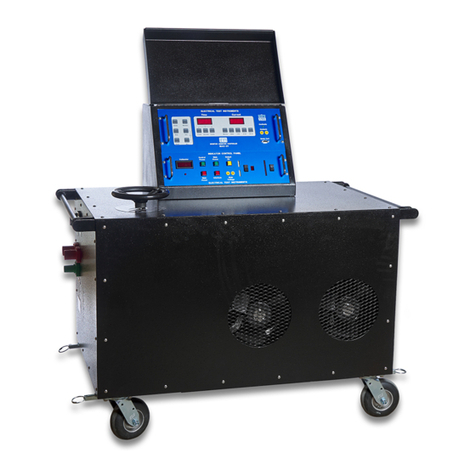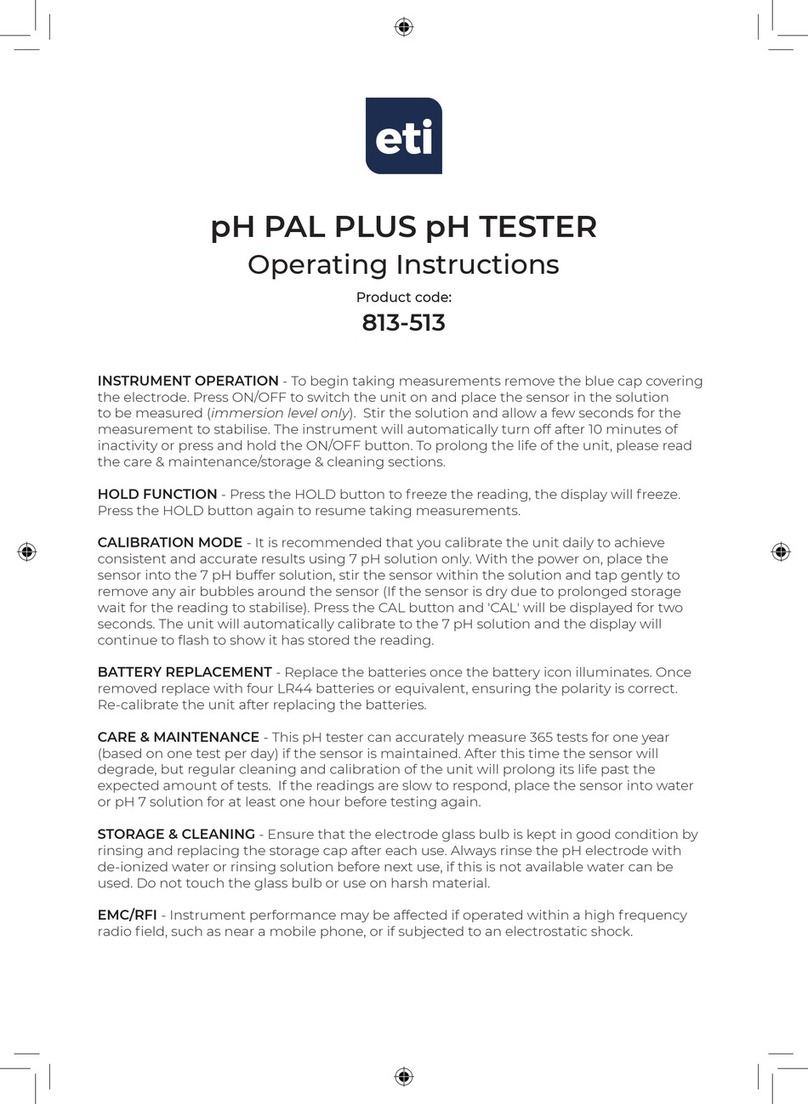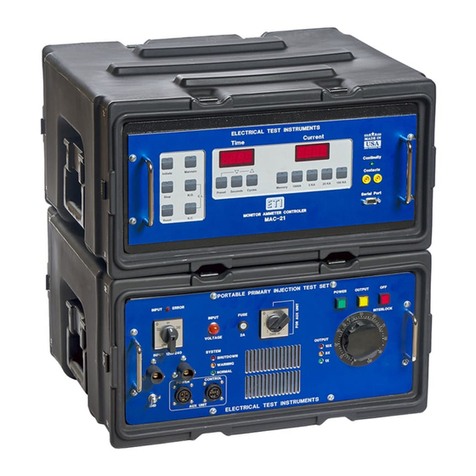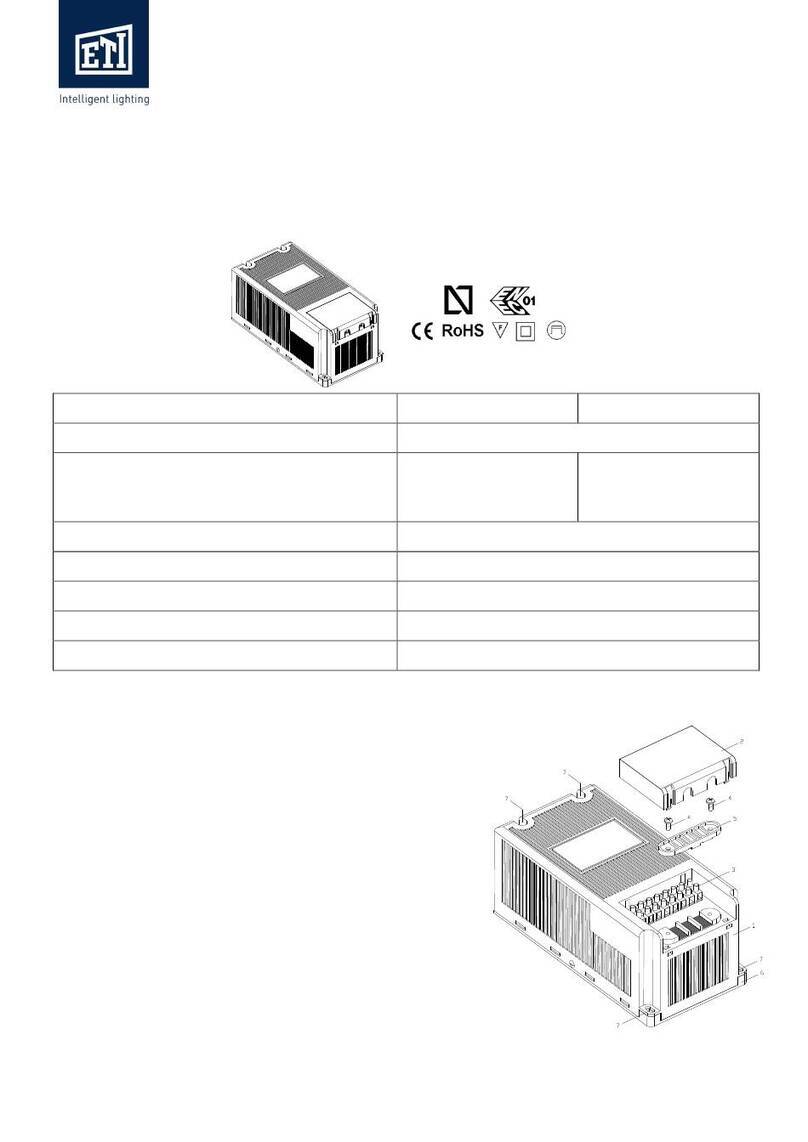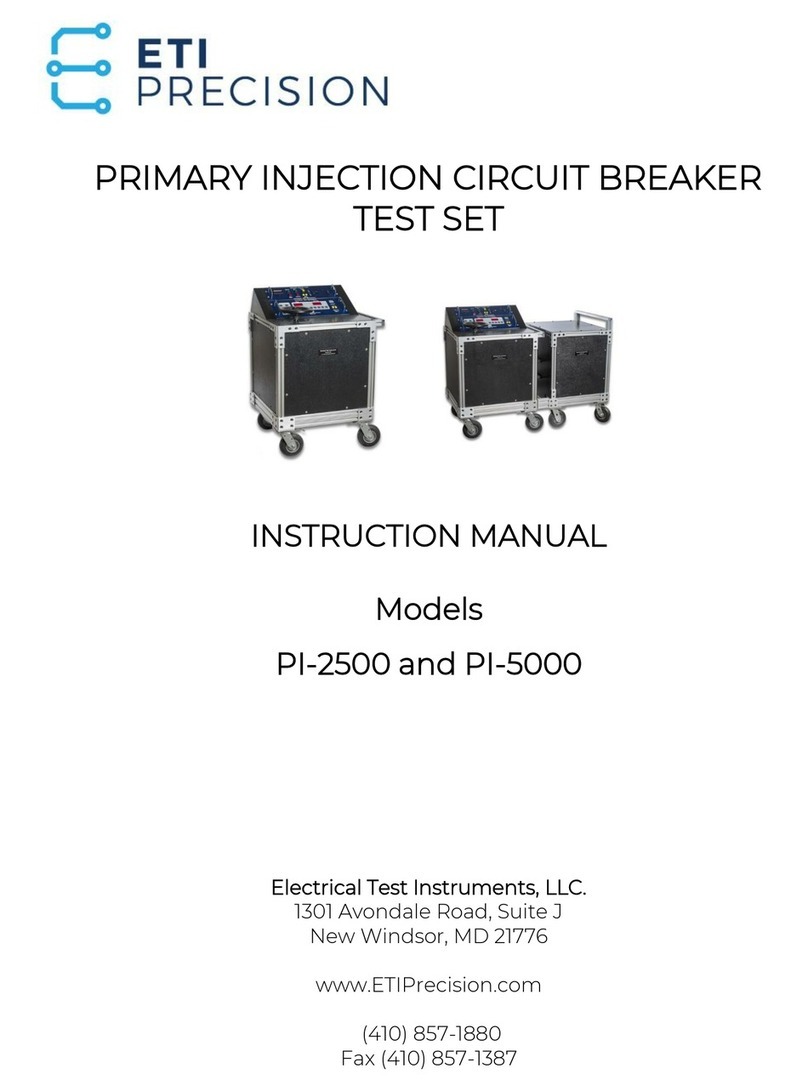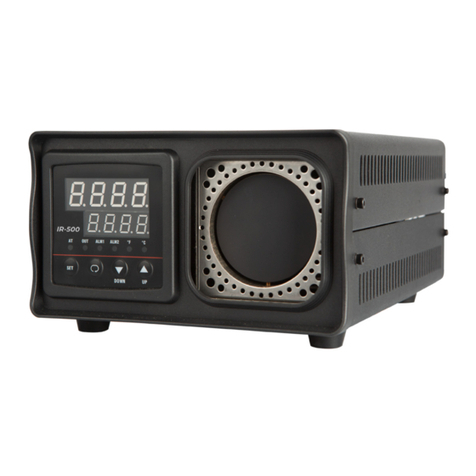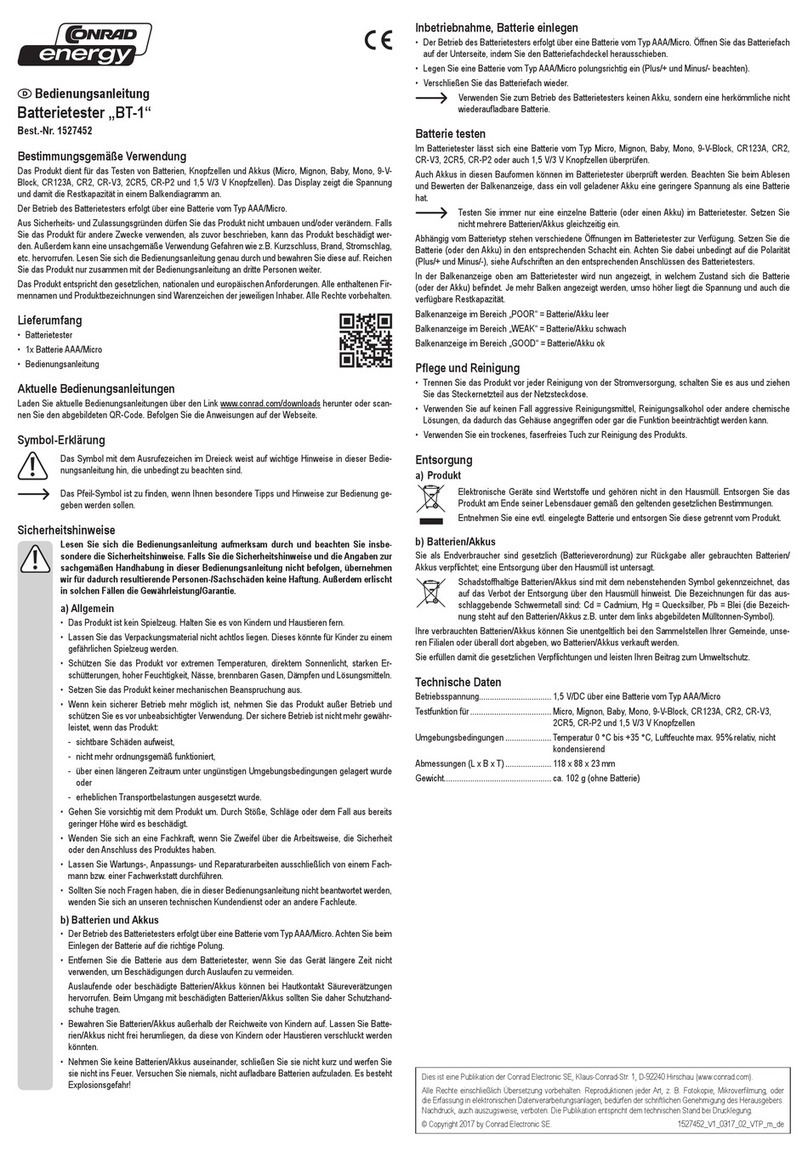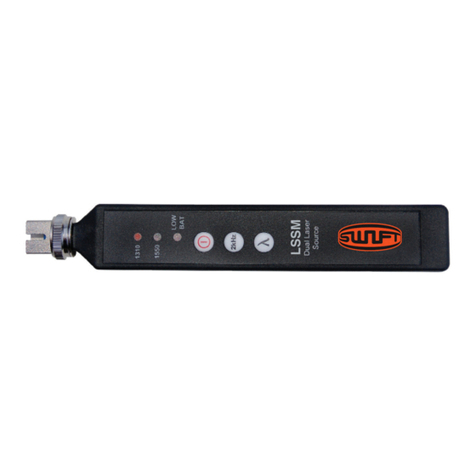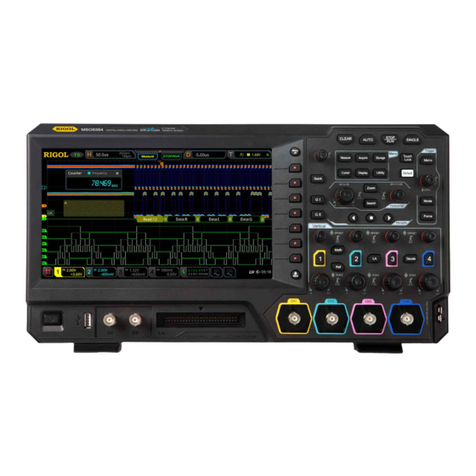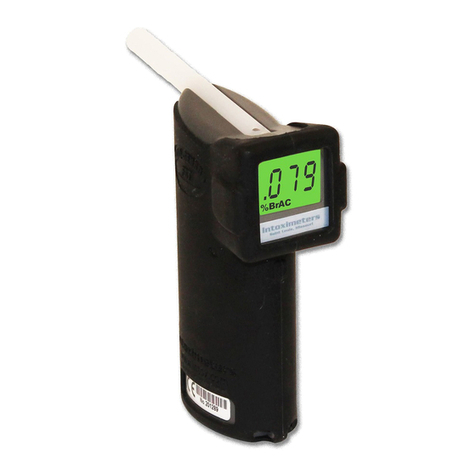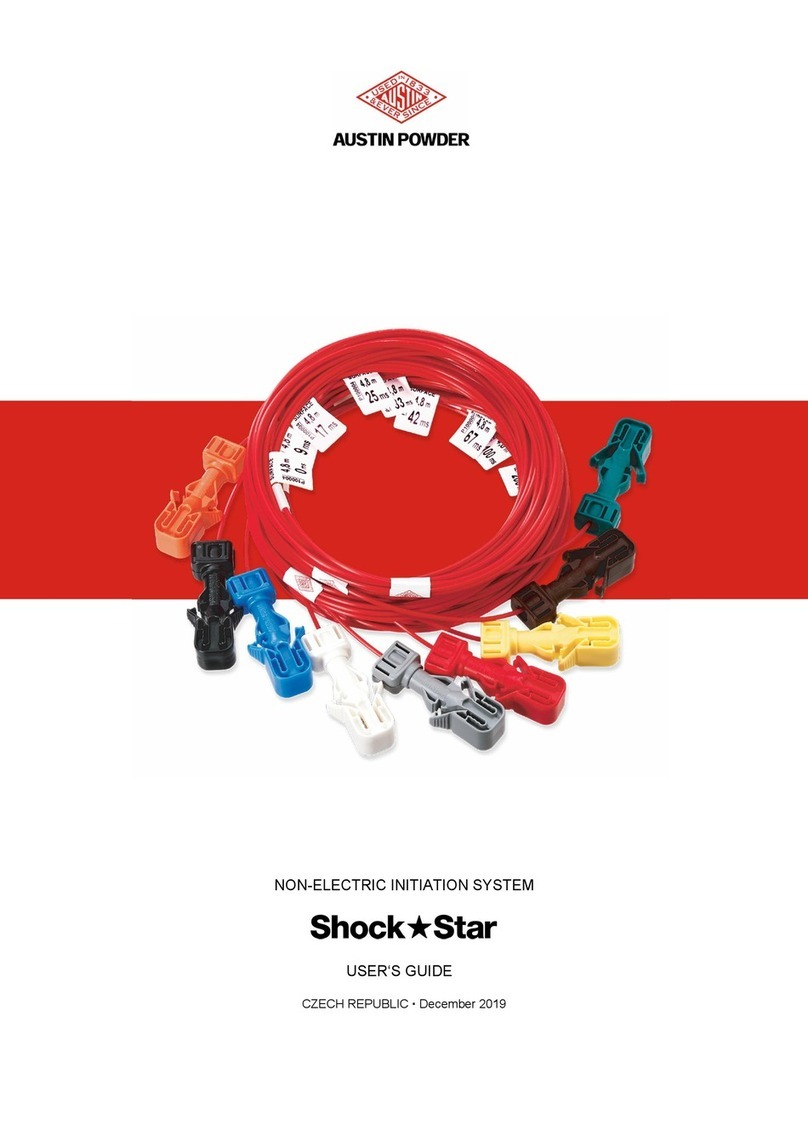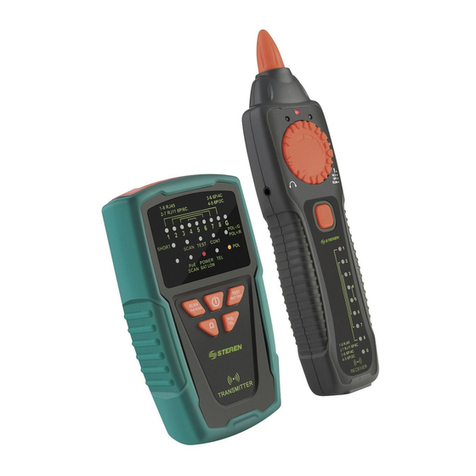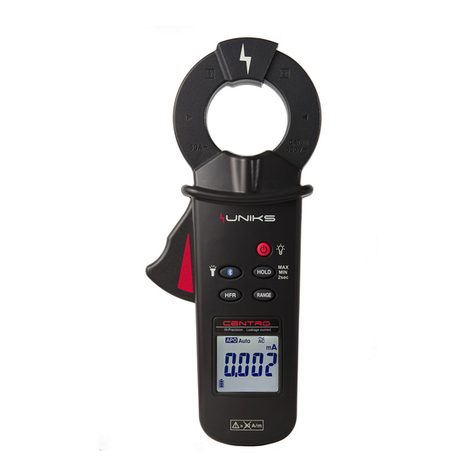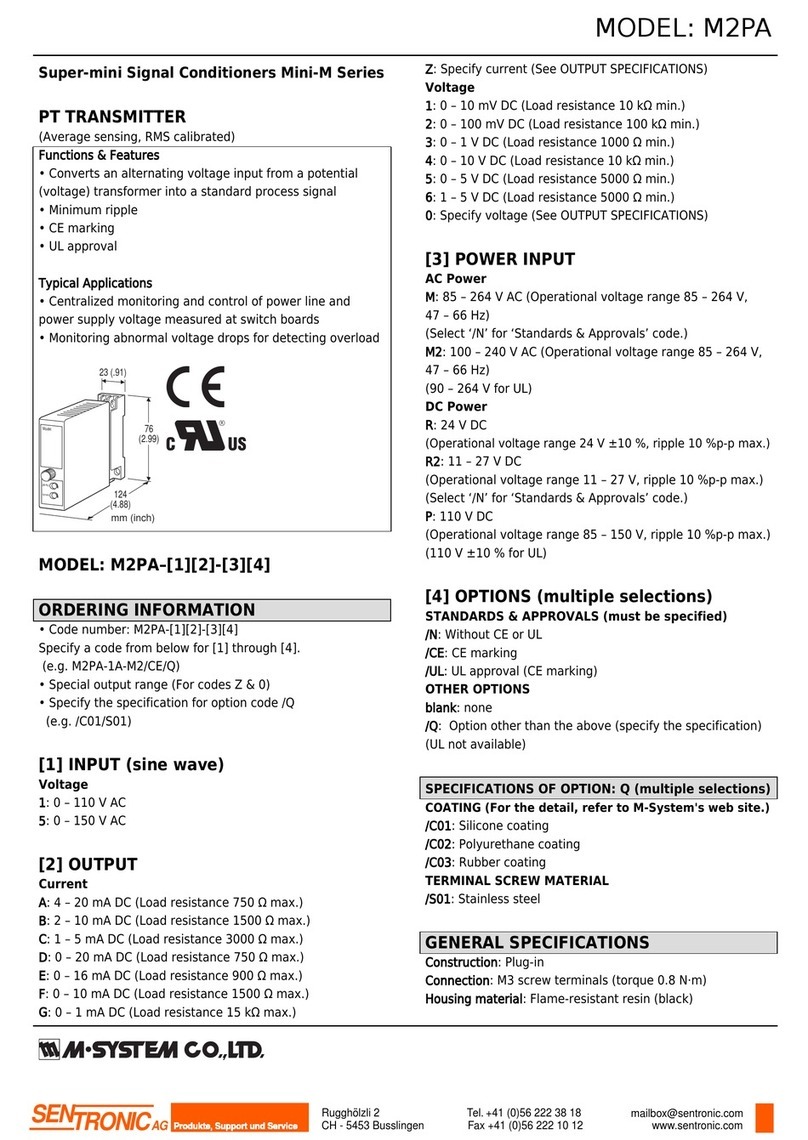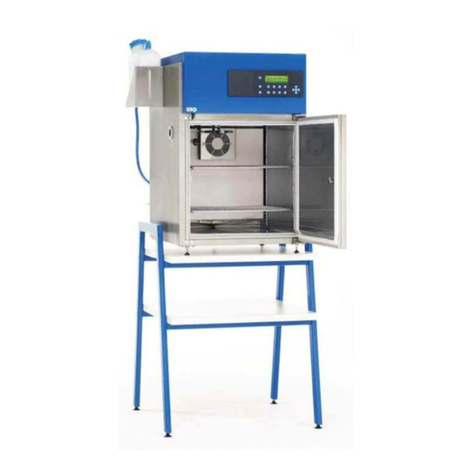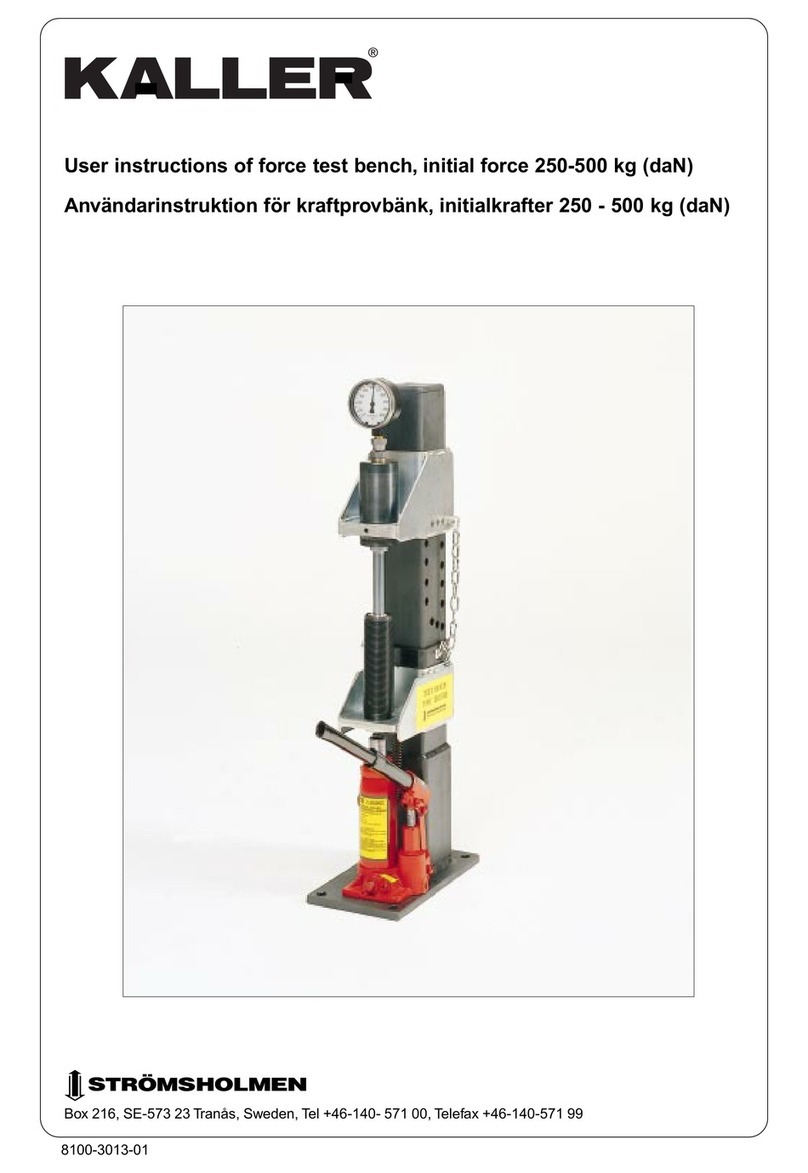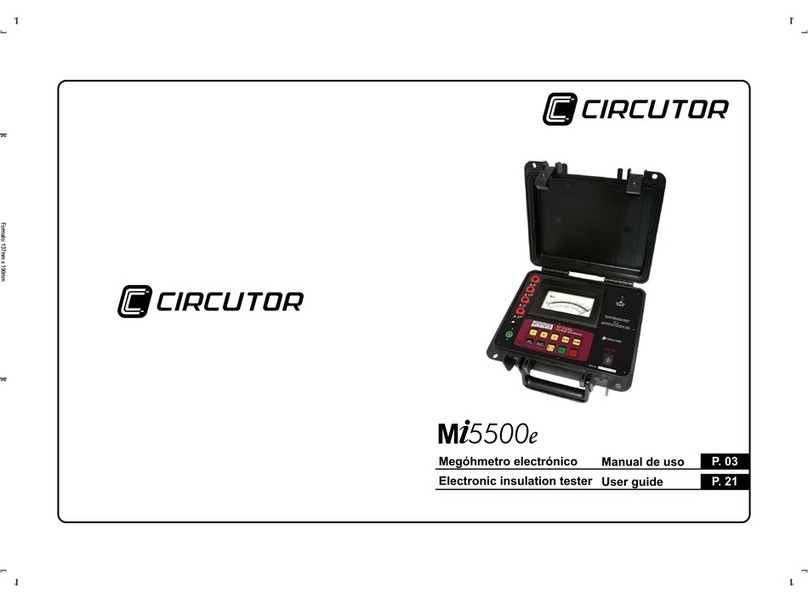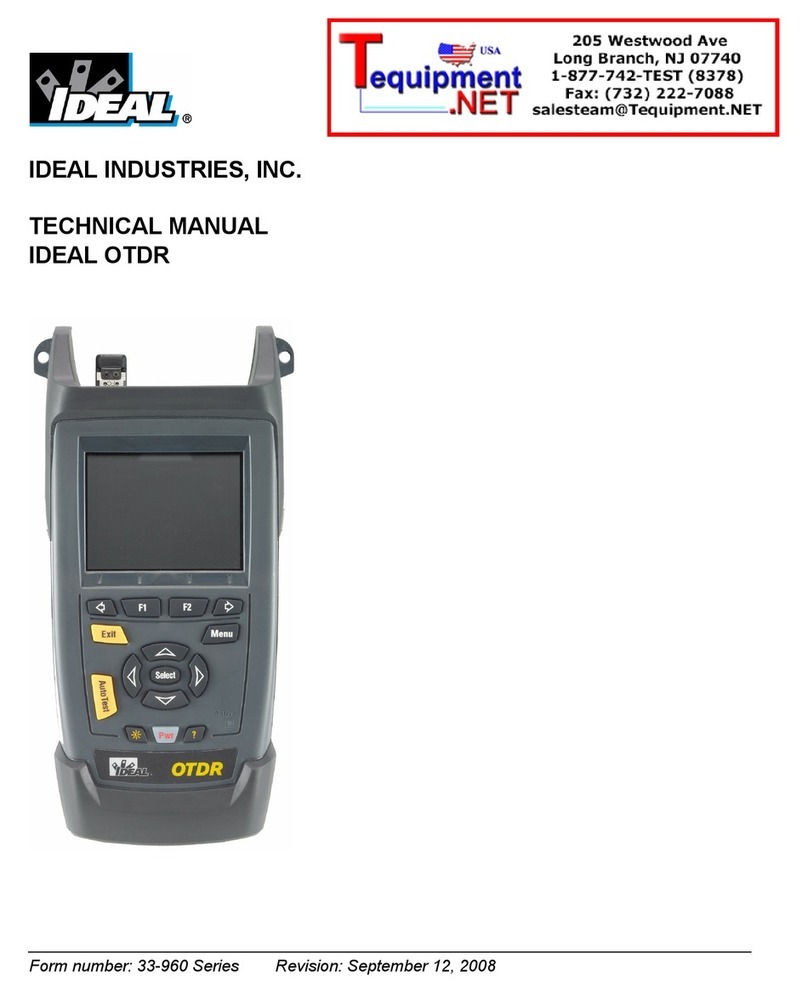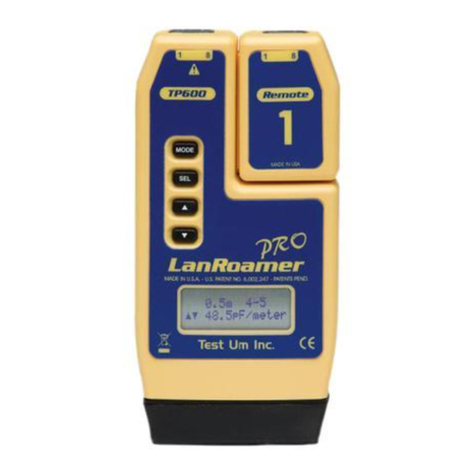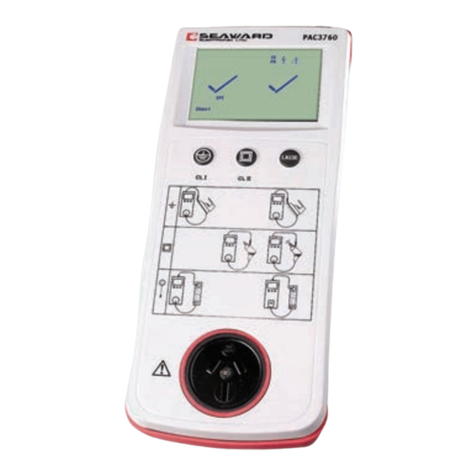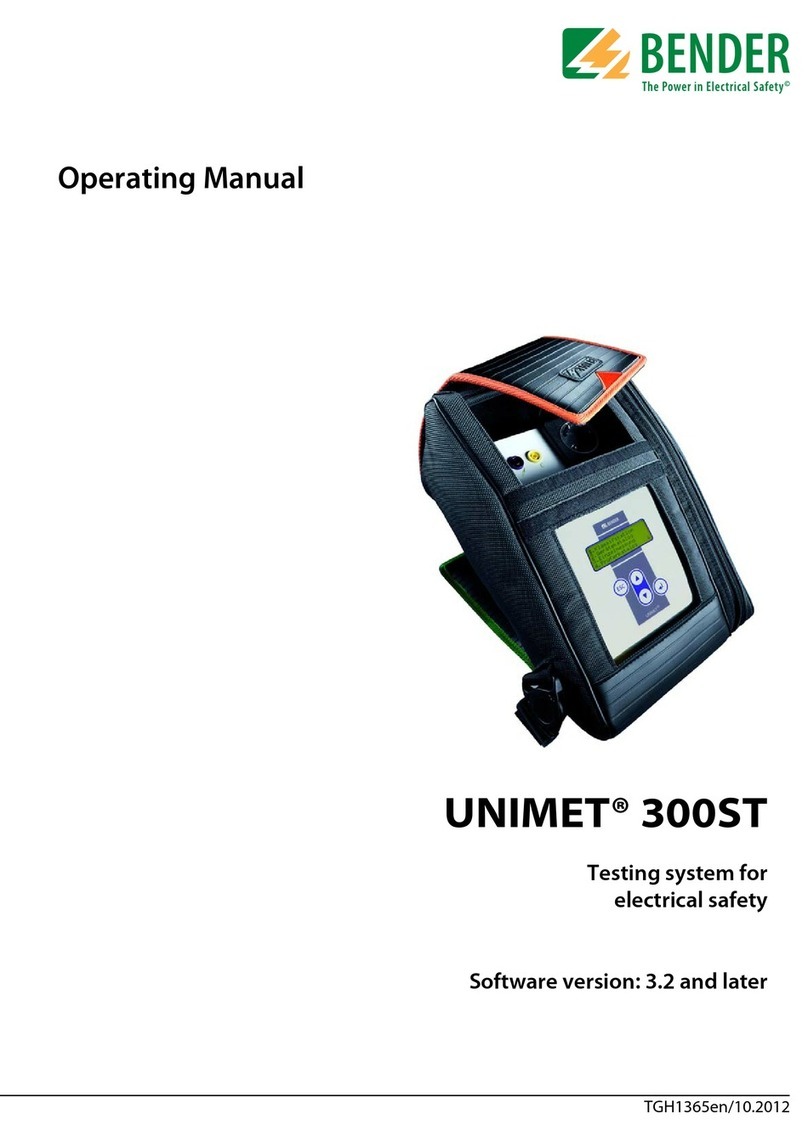ETI PI-4000B User manual

PRIMARY INJECTION CIRCUIT BREAKER
TEST SET
INSTRUCTION MANUAL
Model
PI-4000B
Electrical Test Instruments, Inc.
1301 Avondale Road, Suite J
New Windsor, MD 21776
www.electricaltestinstruments.com
(410) 857-1880
Fax (410) 857-1387

Electrical Test Instruments PI-4000B
==============================================================================
==============================================================================
Copyright (C) 1994-2004 Electrical Test Instruments, Inc. All Rights Reserved
TABLE OF CONTENTS
SECTION I: GENERAL INFORMATION and SPECIFICATIONS
WARNING II-1
Introduction II-2
General Description II-2
Monitor and Controller MAC-21 II-5
Proposed Enhancements II-5
Advantages Compared to Other Test Sets II-6
Trademarks II-6
PI4000B Specifications II-7
SECTION II: DETAILED DESCRIPTION
Theory of Operation
High Current Test Sets II-9
PI-4000B Main Circuitry II-9
PI-4000B Indicator Control Panel Circuitry II-12
Indicator Control Panel II-13
Figure II-2: Retrofit Indicator Panel II-14
SECTION III: MAC-21 Monitor and Controller
MAC-21 Specifications III-1
MAC-21 Unit Circuitry III-2
MAC-21 Software III-2
MAC-21 Parts Identification and Operation III-4
MAC-21 Internal Parts III-8
Figure II-1: Front Panel III-9
Maintenance and Calibration of MAC-21 III-10
Parts List (MAC-21) III-12
Overall Schematic (MAC-21) III-13
SECTION IV: OPERATING INSTRUCTIONS
Pre-Test Installation and Setup IV-1
Basic Guidelines and Suggestions IV-3
Single Pole Molded Case Breakers IV-4
Multi-pole Molded Case Breakers IV-7
Low Voltage Power Breakers IV-10
Motor Overload Relays IV-14
Ratioing Current Transformers IV-16

Electrical Test Instruments PI-4000B
==============================================================================
==============================================================================
Copyright (C) 1994-2004 Electrical Test Instruments, Inc. All Rights Reserved
SECTION V: SERVICE INFORMATION AND DOCUMENTATION
Maintenance and Calibration of PI-4000B V-1
Maintenance and Calibration of MAC-21 V-1
Parts List (PI-4000B) V-4
Parts List (Indicator Control Panel) V-5
Parts List (MAC-21) V-6
Overall Schematic (PI-4000B) V-7
Overall Schematic (Indicator Control Panel) V-8
Warranty END
Additional Schematics END

Electrical Test Instruments PI-4000B
Section II – Detailed Description
==============================================================================
==============================================================================
Copyright(C) 1994-2004 Electrical Test Instruments, Inc. All Rights Reserved
SECTION I
GENERAL INFORMATION

Electrical Test Instruments PI-4000B
Section II - Detailed Description
==============================================================================
==============================================================================
Copyright(C) 1994-2004 Electrical Test Instruments, Inc. All Rights Reserved
Page II-1
SECTION I
GENERAL INFORMATION
WARNING
WARNING - READ THIS ENTIRE MANUAL AND THOROUGHLY
FAMILIARIZE YOURSELF WITH THE UNIT OPERATION PRIOR
TO CONNECTING THE UNIT TO A SOURCE OF POWER. HIGH
CURRENT TEST SETS ARE NORMALLY POWERED FROM
HIGH CAPACITY 208 VOLT TO 575 VOLT SERVICES, AND
IMPROPER CONNECTION OR OPERATION COULD CAUSE
DAMAGE TO THE TEST SET AND EQUIPMENT UNDER TEST,
AS WELL AS CREATE AN UNSAFE CONDITION FOR PERSONS
OPERATING THE SET.

Electrical Test Instruments PI-4000B
Section II - Detailed Description
==============================================================================
==============================================================================
Copyright(C) 1994-2004 Electrical Test Instruments, Inc. All Rights Reserved
Page II-2
INTRODUCTION
A primary injection test set such as the PI-4000B is a device with high current, low
voltage AC outputs for testing direct acting low voltage circuit breakers. Current is
injected through the main contacts of the breaker to simulate actual fault conditions,
which tests the operation of CTs, solid state, thermal, or electromechanical trip devices,
and the actual trip mechanisms and breaker contacts.
GENERAL DESCRIPTION
The PI-4000B is a versatile and technologically advanced primary injection test set
capable of testing circuit breakers up to 4000 amperes frame size. It incorporates an
improved low impedance output transformer with dual primaries to facilitate its use on
power sources of 480 VAC as well as 240 and 208 VAC, and dual secondaries to
provide optimal impedance matching to a wide range of breaker sizes. High capacity
internal fan cooling allows maximum utilization of the output transformer and faster
recovery after overload conditions.
It is housed in a rugged steel enclosure with removable sides and top for easy access to
internal components. The sides are clear of protruding components, and full-width
handles with provisions for lifting hooks are on both ends. Locking swivel castors on all
four corners provide ease of mobility.
The indicator control panel and MAC-21 are mounted in a compact hood with a hinged
lid on the top, which provides maximum protection during transportation and a large flat
area on the top surface for convenient placement of manuals, breaker curve books, and
auxiliary instruments. A hinged access panel in the back of the hood provides a storage
area for manuals, contact leads, fuses, and other small items. The auxiliary 120 VAC
GFI protected outlet is conveniently located on the side of the hood, and protected by
an 8 ampere circuit breaker.
The output stab plates accommodate standard breaker stab adaptors. The rugged silver
plated copper stab adaptors supplied with the test set are designed to be used for both
vertical and horizontal stabs, and have both ½” and ¾” output plates. Standard ½”-13
stainless steel hex head bolts with matching nuts and washers are used to connect the
output stab plates, and they may be replaced easily.
An optional series adaptor assembly allows the output to be configured for continuous
current of 2000 amps at 22 VAC for testing breakers that require connection via cables.
An automatic sensor adjusts the internal CT output for proper readings in either
configuration.
The test set may be plugged into any 60 Hz AC voltage source of 200-250 VAC or 400-
500 VAC, and will work on 50 Hz sources of 200-210 VAC or 400-420 VAC. The line
voltage is displayed on the indicator control panel digital meter. An internal voltage
sensor automatically configures the AC control power for nominal 240 or 480 VAC, and
monitors input voltage for compliance to specifications. The main output section may be
configured by means of a simple rotary switch on the power input panel, and an
interlock allows the power section to be energized only when properly configured for the
applied voltage.

Electrical Test Instruments PI-4000B
Section II - Detailed Description
==============================================================================
==============================================================================
Copyright(C) 1994-2004 Electrical Test Instruments, Inc. All Rights Reserved
Page II-3
The vernier uses a large wheel to adjust the output manually within the range
determined by the coarse tap, as well as a motorized control actuated by means of a
smart control switch. When the switch is pressed briefly, the vernier moves in a very
small increment for fine control. When the switch is held, the vernier moves very quickly,
so that the entire span may be traversed in less than five seconds. The approximate
vernier position is displayed on an LED indicator bar graph. For the PI-4000B, the
vernier is always turned clockwise to increase output.
The electronically controlled tap selection uses power contactors to set the coarse tap.
The unit powers up in the lowest tap position (1), and the setting may be adjusted by
means of a rocker switch on the indicator/control panel. If the switch is held, the taps
change at a rate of about one per second. Tap change is not allowed when output is on.
The indicator/control panel features two temperature indicators: one for the output bus
temperature, and the other for the overall system temperature. This is determined by a
combination of actual winding temperature, and a “virtual temperature” which is derived
from time and current duty cycle usage as monitored by a “POD”, or Programmable
Overload Device. Additional details are available in a separate manual. If either
temperature exceeds a safe operating level, the interlock is asserted and the output
section is de-energized. Additional thermostatic sensors in the output transformer
windings will also assert the interlock if unsafe temperature levels are detected.
The output voltage of the test set is provided on the indicator/control panel for
monitoring by means of a separate digital voltmeter.
Primary catastrophic overload protection for the test set is accomplished with input
fuses having high interrupting current capacity. Overload of the output system is sensed
by means of the previously mentioned “POD” on the vernier autotransformer, and
thermal sensors in each winding and on the SCR. The combination of these devices
allows full utilization of the overload capability of the test set, and eliminates costly and
cumbersome fuse replacement required in other test sets.
The output of the test set is controlled by means of a proven SCR controller. This
provides precise initial phase angle control to reduce DC offset for inductive loads and
more consistent pulse currents. The phase angle is internally adjustable.
The measurement of output current and time is accomplished by means of the proven
MAC-21, which uses highly accurate A/D circuitry and intelligent firmware to resolve
true-RMS values of distorted waveforms. It also provides features such as preset ON
times for convenient jogging of output current without overheating the breaker or
causing unwanted trips.
The entire test set has been designed for reliability, ruggedness, and ease of use.
Sophisticated electronics in the indicator/control panel and the MAC-21 provide state of
the art accuracy and convenience, while simple connections allow for easy removal and
replacement for transportation or service. All covers are removable, allowing easy
access to all internal components. A horizontal relay panel located just under the top
panel contains most of the circuitry, facilitating service and maintenance. Two large
front-mounted fans provide maximum airflow to the transformer and output bus, and
rear exhaust directs air flow away from the operator. The cabinet is designed with no

Electrical Test Instruments PI-4000B
Section II - Detailed Description
==============================================================================
==============================================================================
Copyright(C) 1994-2004 Electrical Test Instruments, Inc. All Rights Reserved
Page II-4
protruding components on the sides, so it can be navigated through narrow doorways
without problems. The input jacks and voltage switch are protected by the heavy duty
full width handles on both ends.

Electrical Test Instruments PI-4000B
Section II - Detailed Description
==============================================================================
==============================================================================
Copyright(C) 1994-2004 Electrical Test Instruments, Inc. All Rights Reserved
Page II-5
MONITOR AND CONTROLLER MAC-21
The MAC-21 microprocessor-based measurement and control unit features digital
readout of current and time enhanced by digital signal processing. Pulse (memory)
mode provides fast and accurate automatic evaluation of output current pulses as short
as one half cycle.
The MAC-21 incorporates a precision A/D converter and special firmware for true-RMS
continuous and pulse current reading with much greater accuracy. It also utilizes a
sophisticated current sensing system for more reliable current latch mode operation and
better timing accuracy. An LED digital readout for current in four ranges from 1000 A to
100 KA reduces the chance of operator error.
An integral autoranging timer with LED readout provides four digits in seconds or cycles
mode, with a resolution of 0.001 second or 0.5 cycle. A preset function allows you to
set a maximum ON time in seconds or cycles, for convenient "jogging" of output to
desired current, or setting time for heat runs and long time tests.
A current hold feature is also built in. When the desired current is displayed, a simple
touch of the MAINTAIN key activates the function, which automatically adjusts the
motorized vernier to hold the current within 5 amperes.
The memory current displayed after a test indicates the true RMS value of the entire
pulse, no matter how long or short it was, except for instantaneous trip, where the peak
RMS value is used. After a test, it is possible to read the peak RMS value, which
indicates the amount of DC offset or distortion, or the last displayed average RMS
reading, which is useful for pickup testing.
The entire metering and control package is designed to be removed and replaced very
easily, so that it may be transported separately.

Electrical Test Instruments PI-4000B
Section II - Detailed Description
==============================================================================
==============================================================================
Copyright(C) 1994-2004 Electrical Test Instruments, Inc. All Rights Reserved
Page II-6
ADVANTAGES COMPARED TO OTHER TEST SETS
Several changes have been made in the design of high current test sets since early
models such as the EIL BTS-50, many of which are important for safety and
convenience of operation.
The oldest test sets, made by companies such as Multi-Amp and EIL, used large
variable autotransformers and high current step-down transformers to generate high
current output. Tapped autotransformers provided coarse steps for several ranges of
output current, as well as selectable input voltage. These old test sets used large, heavy
iron-core CTs to measure output current with iron vane analog meters, often with
pointer preset mechanisms to read current pulses. Times were displayed on
electromechanical timers, suitable only for long time measurement.
Later test sets were improved by the use of air core current sensors, and various
electronic instruments to measure current and time. These devices include the Duffers
current meter, which was essentially peak responding, and the improved Accu-Amp,
which used analog true-RMS circuitry and sample/hold technology. Similar circuitry was
incorporated in the Multi-Amp Mem-Amp.
A major change in transformer design, incorporating multiple primary cores and dual
secondary busses, provided greater efficiency and lower overall weight and size, but
required a single input voltage.
The PLC-2000 used in the EIL PS-250 and PS-600 used a microprocessor to provide
some advanced functions such as autojog and current hold, as well as data collection
and printout, but it was hard to use. Moreover, its current measurement circuitry was
essentially analog, and did not provide accurate true RMS readings.
The Phenix Technologies’ HC-30 and HC-100 used a PC compatible computer and real
time data analysis software to provide some improvement, but it was also hard to use
and suffered from reliability problems due to its complexity.
The MAC-21 Monitor Ammeter Controller used in the PI-4000B has been used with
great success in many retrofits of older test sets. It has been refined to be highly
accurate, reliable, and easy to use. The overall design of the test set incorporates
advanced features which allow use on several input voltages, and allows for very fast
adjustment of output current. Other important advantages are simple current hold
operation, and multi-mode memory current display. The PI-4000B has been improved
with a high efficiency C-core transformer that produces much higher output current at
lower input current, due to low impedance.
TRADEMARKS
1. "Duffers" refers to a device manufactured by Duffers Corporation
2. "Accu-Amp" is a trademark for a device originally made by EIL Instruments, Inc.
3. "SmartCore" is a trademark of ZWorld Engineering, Davis, CA.

Electrical Test Instruments PI-4000B
Section II - Detailed Description
==============================================================================
==============================================================================
Copyright(C) 1994-2004 Electrical Test Instruments, Inc. All Rights Reserved
Page II-7
PI4000B SPECIFICATIONS
INPUT SUPPLY:
208/240 or 480 VAC +/- 10% (Field switchable)
SINGLE PHASE
60 HZ (50 Hz at 10% lower line voltages)
45 KVA (Continuous) at 36 KVA output (80% efficiency)
OUTPUT CURRENT & OVERLOAD CAPABILITIES:
11.5V (Par)
23 V (Ser)
Ovld
Duty
Max ON Time *
Min OFF Time
Max Inp Curr (@480/240)
4000 A
2000 A
1x
100%
CONTINUOUS
N/A
94 / 187
5600 A
2800 A
1.4x
50%
15 Minutes
15 Minutes
140 / 280
8000 A
4000 A
2x
25%
5 Minutes
15 Minutes
187 / 375
12000 A
6000 A
3x
10%
1.5 Minutes
15 Minutes
281 / 562
16000 A
8000 A
4x
6%
45 Seconds
15 Minutes
375 / 750
20000 A
10000 A
5x
4%
4 Seconds
2 Minutes
468 / 937
28000 A *
14000 A *
7x
2%
2 Seconds
2 Minutes
656 / ***
40000 A *
20000 A *
10x
1%
1 Second
2 Minutes
937 / ***
*Available with 480 VAC input only; **** Not available 240 volt input
Max ON Times may be less at 208 or 240 VAC
DIMENSIONS AND NET WEIGHT (Est.)
Height: 45 in. (1140 mm) (includes castors and hood)
Width: 48.0 in. (1219 mm)
Depth: 27.0 in. (686 mm)
Weight: 850 lb. (386 kg)
STANDARD ACCESSORIES
Stabs, BS-50HV (½” bus, horizontal or vertical) 2 each
Stabs, BS-75HV (¾” bus, horizontal or vertical) 2 each
Input power plugs only 2 each
Contacts leads 1 pair
Technical manual 1 copy
OPTIONAL ACCESSORIES
Series bar PN: M-I213
Adjustable Stab System, custom PN: OP-114
MAC Report Generator Software PN: OP-112

Electrical Test Instruments PI-4000B
Section II - Detailed Description
==============================================================================
==============================================================================
Copyright(C) 1994-2004 Electrical Test Instruments, Inc. All Rights Reserved
Page II-8
SECTION II
DETAILED DESCRIPTION

Electrical Test Instruments PI-4000B
Section II - Detailed Description
==============================================================================
==============================================================================
Copyright(C) 1994-2004 Electrical Test Instruments, Inc. All Rights Reserved
Page II-9
SECTION II
DETAILED DESCRIPTION
THEORY OF OPERATION
High Current Test Sets
High current test sets generally consist of the following:
1. One or more coarse taps accomplished by:
(a) A tapped autotransformer providing several equal steps of voltage or
(b) A multi-section output transformer
2. A continuously variable vernier adjustment between coarse taps by means of:
(a) A variable autotransformer and boost transformer, or
(b) A variable autotransformer connected to a section of the output
transformer.
3. An output transformer with one or more isolated low voltage, high current
secondary.
4. Power control circuitry consisting of switches, relays, protective devices, etc.
5. Current measurement circuitry consisting of sensors, current meter, and timer.
In general, a primary voltage is selected by means of a combination of coarse tap and
vernier adjustment. This voltage is stepped down by the output transformer to provide
the desired current into the load impedance.
PI-4000B Main Unit Circuitry
Main power is applied to the PI-4000B by means of standard high current plug and
socket connectors, which are supplied for the customer to connect to the power source
with appropriate flexible leads. A ground terminal with wing nut and washers is provided
for a solid ground connection.
Primary protection is provided by high capacity 200 ampere input fuses (F1 and F2).
After that, the control section is protected by smaller 5 ampere fuses (F3 and F4), and
the power section is isolated by means of high current contactors (K13 and K14).
Transformer T3, protected by fuse F6, steps down the primary voltage by a factor of ½,
and is connected to a wide range switching power supply in the indicator control panel
to provide 12 VDC. Transformer T6, protected by fuse F5, steps it down by a factor of
¼, and this voltage is sensed by a voltage relay circuit. When the primary voltage is
between about 200 and 270 VAC, this circuit allows operation in 240 VAC mode. If the
voltage is between about 420 and 520 VAC, operation is allowed in 480 VAC mode.
Control power cannot be turned on if the voltage is outside these bounds.
When the input voltage selector switch S11 is the 208/240 V position, relay K9 is

Electrical Test Instruments PI-4000B
Section II - Detailed Description
==============================================================================
==============================================================================
Copyright(C) 1994-2004 Electrical Test Instruments, Inc. All Rights Reserved
Page II-10
energized, setting the primary windings of transformer T4 in parallel. This also
energizes relay K1 on the voltage sensor PCB, and provides an interlock and input
selector error indication. The voltage sensor PCB rapidly flashes the Input Select Error
LED on the control panel for 5 seconds during startup, and then turns off if input voltage
is within bounds as determined by the input selector switch position. If line voltage is
incorrect, the Input Select Error LED will flash, and control power cannot be turned on. If
control power is energized, brief voltage sags or surges will flash the LED as a warning.
If such voltage excursions persist for longer than about 0.2 seconds, the control power
will drop out.
Binding post BP1 is provided for separate connection to an earth ground, to check for
ground integrity. When there is continuity from this point to chassis ground, relay K2 on
the voltage sensor PCB is energized, and enables the interlock for control power. If
ground integrity is not sensed, the Ground Open LED DS1 will light. A separate lead
should be connected to the external equipment ground system to verify that the main
grounding cable is intact. Do not defeat this safety feature by jumpering the ground
binding post to the test set frame.
When the control power switch in the indicator control panel is pressed, and all voltage
interlocks are OK, relay K10 is energized, which provides 120 VAC control power to the
entire test set, including the fans and the auxiliary GFI outlet, protected by 8 ampere
circuit breaker CB1.
If all power interlocks are OK, the Main Power switch in the indicator control panel may
be pressed to activate main contactors K13-14. This provides high current power to the
test set output circuitry through the SCR controller. The switched output voltage is
supplied to distribution blocks DB1 and DB2.
The vernier autotransformer T1 and output transformer T2 are connected to input
voltage selector switch S11. This allows for connection in series for 480 VAC, and
parallel for 208/240 VAC. Vernier T1 is connected directly to the first primary of T2, so
that clockwise rotation produces an output voltage of about 0-1.5 VAC. Relays K1, K2,
and K3 connect the second primary windings for fixed outputs of 0, 1.25, or 2.50 VAC
for taps 1, 2 and 3. For subsequent taps, the large sections T2C, T2D, and T2E are
added to the circuit, while the second section alternates between 1.25 and 2.5 VAC, for
a series of nine (9) overlapping output ranges up to 11.5 VAC.
Output current is detected by means of an air core CT around both main busses. When
the series bar is attached to the output, a switch is actuated, which divides the signal by
a factor of 2. Calibration of series and parallel modes is accomplished with
potentiometers on the S/P calibration/switch assembly under the output face plate.
The output section is energized when a signal is applied to the trigger board of the SCR
controller. The initial phase angle is determined by a zero crossing detector in the
trigger PCB, and a delay which is normally preset to 70 degrees.
The vernier autotransformer may be adjusted manually by means of a handwheel, or by
activating the motor drive. Increasing output is clockwise for all taps.
When T1 is energized, 120 VAC is applied to the primary of T5. This provides a voltage
of about 12 VAC which is used for output ON detection in the indicator control panel.

Electrical Test Instruments PI-4000B
Section II - Detailed Description
==============================================================================
==============================================================================
Copyright(C) 1994-2004 Electrical Test Instruments, Inc. All Rights Reserved
Page II-11
Thermistor TH1 senses the temperature of the output bus, and TH2 reads the
temperature of the first primary of T2. These normally have a resistance of 10 K ohms
at room temperature, and lower values as the temperature increases.
Relays K1 through K6 are energized through the indicator control panel. Relays K1, K2,
and K3 are equipped with a electrical interlocks to avoid damage if all three are
simultaneously energized. Catastrophic protection is provided by fuses F7 through F16.
The adjustable vernier assembly in the PI-4000B consists of a stack of four 120 VAC
decks, with each series connected pair connected to a 240 VAC primary on T2A. Minor
voltage imbalance up to about 2 VAC is corrected by means of paralleling transformer
T7, and actual current in each primary circuit is monitored by means of 50:5 current
transformers T10 and T11. Resistors R1 through R4 ensure voltage balance on the
series connected pairs, and also provide a resistive load to stabilize the SCR controller
at low output settings.
The secondary currents from T10 and T11 are monitored by the Programmable
Overload Monitor (POD), which also measures actual temperature in the primary
winding of T2A. The overall system status is displayed on the bargraph of the indicator
control panel, and an interlock relay shuts down the output of the test set if abnormal
conditions are detected. More details are in a separate manual.
The voltage on the coil of interlock relays K13 and K14 is monitored by interlock
detector relay K7. If the voltage drops to a point where the relays would drop out, this
module turns off the signal to the SCR trigger board, so as to turn off main output
current before the interlock relays actually open.
The PI-4000B features a very efficient low impedance output transformer with enhanced
reliability and cooler operation due to output plates brazed directly to the secondary bus
conductors. The high strength and corrosion resistant stainless steel output bolts should
rarely require replacement, but may be serviced by simply removing the sixteen screws
on the phenolic output faceplate, and then removing one of four bolt retainers. The
standard hex head bolts may then be pushed through and replaced. The bolt retainers
for the upper bolts in the lower plates are also the air core CTs.

Electrical Test Instruments PI-4000B
Section II - Detailed Description
==============================================================================
==============================================================================
Copyright(C) 1994-2004 Electrical Test Instruments, Inc. All Rights Reserved
Page II-12
PI-4000 Indicator Control Panel Circuitry
The power for the control panel is provided by the INV/2 circuit, which is the main input
voltage divided by 2. This voltage, ranging from 104 VAC to 240 VAC, powers a wide
range switching power supply, which supplies 12 VDC to the rest of the circuitry. When
the CTL ON switch S1 is pressed, DS1 lights and relay K4 is energized, and latches on
if voltage interlocks are OK and the external control relay energizes. K4 also provides
12 VDC power to the PC board, which has circuitry for vernier position display and
adjustment, tap selection and display, and temperature readings. Pressing S2 turns
control power off.
If any external interlock is open, as sensed by K1, indicator DS4 will light. Otherwise, K2
will energize, which energizes K2 and allow operation of S3. When MAIN ON switch S3
is pressed, relay K3 energizes, MAIN READY lamp DS3 lights, and power is provided to
external main contactor. If it operates, K3 is latched on through its auxiliary contact.
If the output of the test set is ON, 12 VAC will be applied to DS5, and also will be
sensed by the PC board, which will inhibit tap change.
The INV/4A and B signals provide a voltage equal to ¼ the input voltage. This is
rectified and filtered by the metering PC board, and displayed on the panel meter.
Output is inhibited during tap change or when an interlock condition exists. An interlock
(INTLKB) will be asserted if either temperature readouts exceed an adjusted setpoint.
The vernier position signal is supplied to the PC board, and displayed as a 0-100%
reading on a ten segment LED bargraph. The signal is about 1.0 to 4.0 VDC.
The bus temperature is from a 10 K ohm thermistor. System temperature is a variable
voltage from the POD, as discussed elsewhere. Circuitry in the PC board converts
these signals to voltages which are displayed on multicolor bargraphs. When the signal
exceeds that which lights one red bar, the interlock is tripped.
The output voltage of the test set is supplied at binding posts BP1 and BP2.
Indicator Control Panel
Input Voltage Meter: This LED panel meter indicates the approximate input voltage
applied to the test set.
Control Power ON switch: This green switch turns on 120 VAC control power to the
test set, and its green lamp lights when ON.
Control Power OFF switch: This red switch turns off the 120 VAC control power to the
test set.
Main Power READY switch: This green switch turns on the main power to the output
section of the test set, and its green lamp lights when ON.
Main Power INTERLOCK switch: This red switch turns off the main power to the test
set. It lights if an interlock condition is detected.
Output ON indicator: This yellow lamp lights when output voltage is ON.

Electrical Test Instruments PI-4000B
Section II - Detailed Description
==============================================================================
==============================================================================
Copyright(C) 1994-2004 Electrical Test Instruments, Inc. All Rights Reserved
Page II-13
Output Voltage binding posts: These binding posts are connected to output stabs 1
and 4, and may be used to monitor voltage on the breaker with a DMM.
Thermal Status - Bus: This multicolor bar graph indicates approximate temperature of
the output bus. Green bars indicate normal temperature. Yellow bars indicate significant
heating, and heavy testing should be postponed until unit cools. Red bars indicate
overheating, and unit must cool to yellow range before testing. Output initiation will be
inhibited if second red bar lights. Excessive temperature may indicate poor output
connections.
Thermal Status - System: This indicates temperature of the output section, and other
conditions, as determined by the POD. A thermistor in the winding of the first section of
the output transformer provides actual temperature, but the POD also calculates a
“virtual” temperature based on overload duty cycle limits as indicated in the
specifications. The ten bargraph LEDs correspond to temperatures of approximately 80
to 280 degrees F, with about 20 degrees per bar. Testing is allowed up to a reading of
two red bars, but will then be inhibited until temperature cools to no more than four
yellow bars.
Coarse Tap Switch: This rocker switch selects the coarse tap. The unit powers up in
tap 1. Pressing the switch briefly UP or DOWN will raise or lower the tap by one.
Holding it will change taps about one per second.
Coarse Tap Indicator: This seven segment red LED indicates tap position from 1 to 9.
Vernier Indicator Bargraph: This ten segment red LED indicates approximate vernier
position. 0 or 1 segment lit indicates minimum position, and 9 or 10 segments lit
indicates maximum position.
Vernier Adjust Switch: This rocker switch adjusts the vernier position. Pressing it
briefly UP or DOWN causes the vernier to move by a very small increment, for fine
control. Holding it for about a second will cause the vernier to move very quickly, for
rapid rough adjustment.

Electrical Test Instruments PI-4000B
Section II - Detailed Description
==============================================================================
==============================================================================
Copyright(C) 1994-2004 Electrical Test Instruments, Inc. All Rights Reserved
Page II-14
Figure II-2 – Indicator Control Panel
Thermal
Status
Bus
Vernier
w
w
ON
Stab
Voltage
READY
INTERLOCK
ON
OFF
Output
MainControl Coarse Tap Vernier
Power
Input Voltage
0%
50%
Electrical Test Instruments, Inc.
Indicator Control Panel
Power
Input
Selector
Error

Electrical Test Instruments PI-4000B
Section II – Detailed Description
==============================================================================
==============================================================================
Copyright(C) 1994-2004 Electrical Test Instruments, Inc. All Rights Reserved
MEMORY AMMETER CONTROLLER
MAC-21
INSTRUCTION MANUAL
Firmware Version 3.06 and above
Electrical Test Instruments, Inc.
1301 Avondale Road, Suite J
New Windsor, MD 21776
www.etiinc.com
(410) 857-1880
Fax (410) 857-1387

Electrical Test Instruments MAC-21
Section III – MAC-21
==============================================================================
==============================================================================
Copyright(C) 1994-2004 Electrical Test Instruments, Inc. All Rights Reserved
Page III-1
MAC-21 Specifications
INPUT POWER:
120 VAC, SINGLE PHASE
50/60 HZ, 20 VA Max
CURRENT RANGES:
0-1,000 / 5,000 / 25,000 / 100,000 Amperes
CURRENT ACCURACY:
+/- 0.5% Reading + 0.5% Range + 1 Digit (Continuous)
+/- 1.0% Reading + 1.0% Range + 1 Digit (Pulse > 0.01 sec)
TIMER RANGES:
0-9.999 / 0-99.99 / 0-999.9 / 0-9999 Seconds
0-999.9 / 0-9999 Cycles
TIMER ACCURACY:
+/- 0.005 sec +/- 0.005% of reading +/- 1 count
DIMENSIONS AND NET WEIGHT
Height: 7.0 in. (178 mm)
Width: 19.0 in. (483 mm)
Depth: 2.0 in. (51 mm)
Weight: 3.7 lb. (1.68 kg)
STANDARD ACCESSORIES
Remote Initiate cable 1 S-B143
Contact Leads 1 pair S-A108
Table of contents
Other ETI Test Equipment manuals
